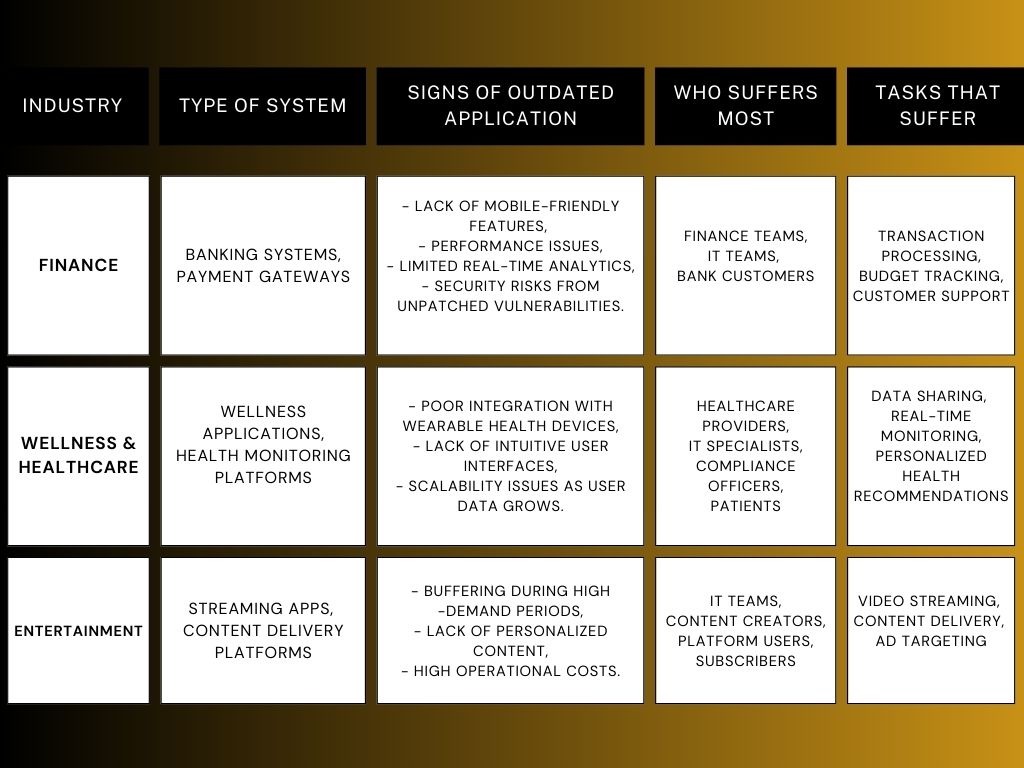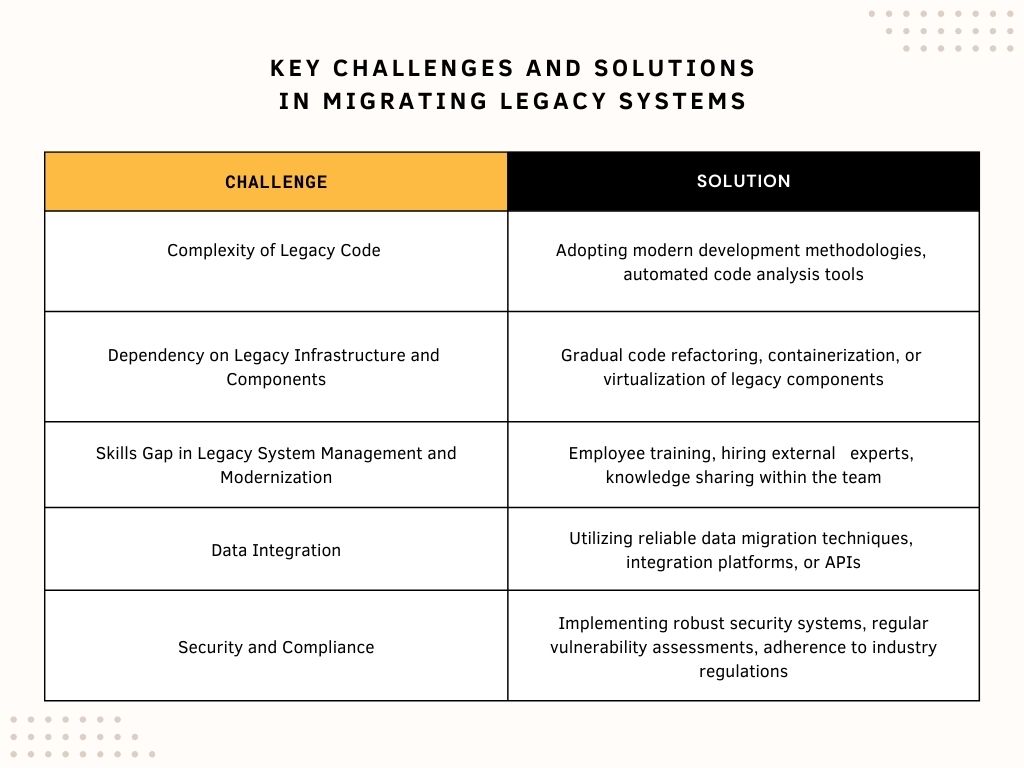How to Master Legacy Application Modernization: Best Practices and Key Challenges
Intro
Is your company’s application holding you back? Imagine trying to meet customer expectations for smooth mobile experiences or quick updates, but being stuck with slow, outdated software. This guide will equip you with the best practices to modernize legacy systems and help your clients achieve their digital transformation goals.
How to Identify When Your Application Needs Modernization
According to the Red Hat Survey, 95% of respondents believe that modernizing legacy systems is essential for their organization’s success, with 51% planning to upgrade over half of their custom applications within the next year. The need for legacy application modernization is highlighted by key symptoms that indicate an outdated system, including slow performance, frequent system crashes, lack of vendor support, and high maintenance costs.
Lack of Modern Interfaces and APIs
Legacy systems often struggle with outdated interfaces and lack robust APIs, making it difficult to integrate with modern technologies.
For startups and SMEs, younger, tech-savvy customers expect instant access to their data through apps. For instance, a finance app user could want to check their loan application status or initiate a transfer while commuting. When these features are difficult or impossible to implement due to legacy code limitations, users often grow frustrated and switch to competitors with more advanced capabilities.
Performance Issues
The decline in legacy applications performance can be seen through longer load times for tracking user activity or financial data, delays in syncing information from connected devices, or frequent app crashes during peak usage hours. Users may find themselves manually inputting data or experiencing delays in real-time updates when the app fails to keep up.
Security Risks
Legacy software systems, common in businesses of all sizes, may have vulnerabilities like hardcoded passwords or unencrypted protocols that were once secure but are now liabilities. Lacking updates to defend against modern threats, such as ransomware or data breaches, these systems put operations and sensitive data at risk. Development teams and IT professionals must urgently patch vulnerabilities or rewrite outdated solutions that no longer have vendor support.
High Maintenance Costs
Maintaining outdated systems leads to temporary fixes that don’t solve underlying issues. These systems require specialized expertise in legacy programming and aging hardware, as skilled professionals retire or shift to modern technologies. Frequent breakdowns, costly repairs, and increased security vulnerabilities raise operational expenses, limiting startups and SMEs’ ability to invest in innovative mobile app development for growth.

Challenges in Modernizing Legacy Applications
Modernizing legacy applications comes with a set of challenges that can hinder progress if not addressed strategically. Organizations must contend with potential disruptions to operations, data loss, and security breaches. Resistance to change from employees and the need to acquire new skills can also pose challenges. To navigate these complexities, many organizations benefit from engaging experienced teams who can offer comprehensive solutions, including backend, frontend, and database management.
1.
Outdated Code: The Need for Legacy Refactoring
Outdated code that is incompatible with modern frameworks limits scalability and innovation. Legacy Refactoring — cleaning up messy code — is essential for maintainability and enabling new features.
2.
Dependence on Outdated Infrastructure
Many applications rely on outdated components, limiting compatibility with modern technologies like cloud computing or mobile systems. Legacy replatforming involves adapting these systems to work on updated platforms, ensuring they can integrate with current technology without requiring a complete rewrite.
3.
Skills Gap in Legacy System Management
Legacy application modernization faces a skills gap due to outdated technologies which modern developers often lack experience with. Rapid technological advances widen this gap, as newer skills in cloud-native and AI/ML development take precedence.
This divide presents both operational and strategic challenges, as legacy systems remain critical for many businesses while innovation demands modern expertise.
4.
Data Migration and Integration
Data migration involves transferring critical data, such as user information and transactions, to the new system while ensuring accuracy and functionality. This may also require refactoring legacy code for smooth integration. The main challenges include maintaining data integrity, consistency, and compatibility across systems.
Reliable tools like ETL processes and API gateways are essential for a smooth transition and ensuring real-time data flow between systems.
5.
Security and Compliance
Legacy systems may no longer meet modern security and compliance standards, exposing businesses to risks, especially when handling sensitive data. Transitioning to a new platform involves upgrading security protocols and adopting modern architectures while ensuring regulatory compliance. This is a key concern for business owners, developers, and compliance officers.
During modernization, ensure compliance with market regulations, especially when handling sensitive customer data. This includes encrypting data both in transit and at rest, implementing multi-factor authentication, and regularly auditing systems for vulnerabilities. This proactive approach to security minimizes the risk of data breaches.

Top 6 Questions About Legacy Application Modernization
1. What is reutilizing or encapsulating, and how does it help modernize legacy applications?
Reutilizing or encapsulating legacy applications involves isolating data and integrating it with modern APIs, preserving core functionality without rewriting the code. This approach enables interaction with newer technologies, facilitates gradual modernization, and reduces risks.
2. How can application rehosting facilitate a smoother transition to the cloud?
Application rehosting can facilitate a smoother transition to the cloud by enabling quick migration with minimal disruption to business operations. It reduces complexity by avoiding major code changes and leveraging existing application knowledge, allowing organizations to realize cloud benefits faster.
3. What minimal changes are required for replatforming a legacy application?
Replatforming a legacy application involves minimal changes such as updating configuration files, network settings, and making UI improvements. Replatforming can not only reduce maintenance costs by transitioning to a more scalable platform, but it can also improve uptime and reduce the risk of security breaches. This makes it a wise investment for businesses aiming to stay competitive in the digital landscape.
4. Why is refactoring an essential strategy for tackling technical debt in legacy systems?
Refactoring is essential for tackling technical debt in legacy systems as it improves the code quality and maintainability, making the system easier to manage and update over time. It also simplifies complex code structures, reduces technical debt, and supports incremental modernization without disrupting the existing functionality.
5. How does rearchitecting improve the features and capabilities of an old application?
Rearchitecting improves the features and capabilities of an old application by transitioning it to a more flexible and scalable architecture, such as microservices. This enables better performance, adaptability, and the ability to integrate new technologies while reducing maintenance costs and enhancing the overall user experience.
6. When should you consider rebuilding an application from scratch, and what are the benefits?
You should consider rebuilding an application from scratch when the existing system is costly to maintain, technologically outdated, or unable to meet evolving business requirements. The benefits include implementing modern architecture, utilizing better technologies, and improving the overall user experience while fixing past mistakes.
Ready to Modernize?
Case Studies: Successful Legacy App Modernization
Real-life examples are crucial for demonstrating the potential benefits and challenges of upgrading old applications. Below are two case studies from different industries that highlight successful transformations of legacy systems, each using distinct strategies to achieve measurable results.
1.
Case Study 1: Revamping a Mobile App for a Beverage Producer
Challenge: Legacy app modernization for iOS and Android platforms
A major beverage producer in Saudi Arabia faced issues with its slow, unreliable, and hard-to-maintain app, which was essential for monthly promotions and customer engagement.
Solution:
Touchlane modernized the app by using Kotlin, Swift, and Firebase, improving performance, security, and user experience.
Results:
- Faster load times and smoother interactions
- A more intuitive, visually appealing interface that boosts user satisfaction
- Increased user engagement through promotions
- Reduced maintenance costs through optimized architecture and cloud solutions
2.
Case Study 2: Modernizing a Mobile App for a Finnish Savings Bank
Challenge: Reworking a mobile banking app to meet next-gen securityA Finnish savings bank needed to modernize its outdated app to improve functionality, security, and the user interface.
Solution:
Touchlane revamped the app by upgrading the technology stack, improving the UI, and enhancing security with features such as biometric authentication and encryption.
Results:
- Stronger security, protecting user data
- A more intuitive and user-friendly interface
- New features, including mobile payments and personalized financial insights
- Positive feedback from 85% of users, meeting customer needs
Conclusion
Legacy app modernization offers significant opportunities for businesses to improve efficiency, reduce costs, and enhance customer experience. By upgrading outdated systems and integrating modern technologies like cloud-based platforms, businesses can streamline operations, enhance efficiency, and reduce costs. Whether you’re looking to improve a mobile app or enhance backend systems, now is the time to make the transition.
Don’t let legacy systems slow you down. Contact a digital transformation consultant today to evaluate your current app infrastructure and create a tailored plan for modernization.
RELATED SERVICES
CUSTOM MOBILE APP DEVELOPMENT
If you have an idea for a product along with put-together business requirements, and you want your time-to-market to be as short as possible without cutting any corners on quality, Touchlane can become your all-in-one technology partner, putting together a cross-functional team and carrying a project all the way to its successful launch into the digital reality.
If you have an idea for a product along with put-together business requirements, and you want your time-to-market to be as short as possible without cutting any corners on quality, Touchlane can become your all-in-one technology partner, putting together a cross-functional team and carrying a project all the way to its successful launch into the digital reality.
We Cover
- Design
- Development
- Testing
- Maintenance











